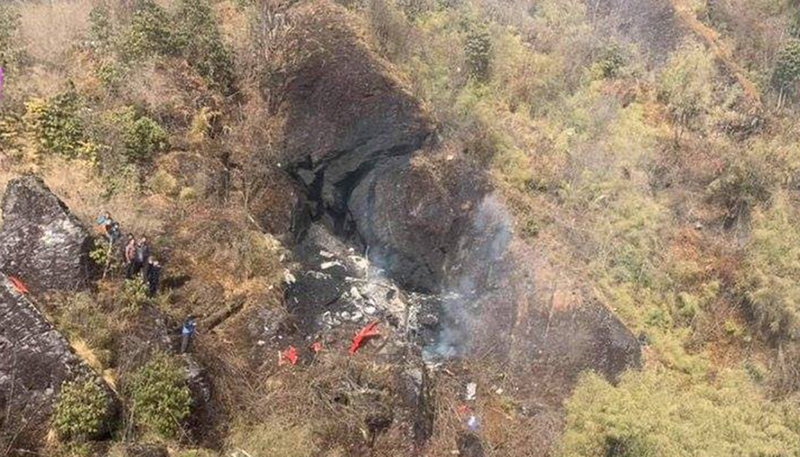Probe marred by glaring negligence
Kathmandu, March 19
It was only after over a week following the high profile Air Dynasty crash in Taplejung that members of the investigation commission said they had made an aerial observation of the crash site apart from landing at the Pathibhara temple.
“The investigation team which flew to Pathibhara on March 10 made an aerial inspection of the crash site as the chopper could not land there due to bad weather condition,” Buddhi Sagar Lamichhane, member secretary of the panel, told THT.
Though the delay in reaching the crash site was attributed to inclement weather, this is clearly inexcusable as far as timely gathering of evidence is concerned, as Pathibhara area is readily accessed by numerous devotees by road. Lamichhane, however, claimed that the team was about to receive evidences and equipment traced at the crash site as soon as possible. As per aviation experts, the delay has contributed to unwarranted tampering with crucial evidence by security forces under instructions to find the minister’s bodyguard’s personal weapon.
“The revolver and ammunition, now under Nepali Army’s custody, needed forensic examinations to preclude the possibility of discharge mid-flight, unintentional or otherwise,” an expert shared. Lamichhane, who also heads the aviation security division at the Ministry of Culture, Tourism and Civil Aviation, said the need for forensic examinations would be discussed only after receiving other evidences from crash site. “We have also been consulting the manufacturer as well as the French air accident investigation experts,” he added. As per standard aviation security procedures, the weapon and ammunition need to be kept separately for obvious reasons, which now cannot be conclusively established by the commission as the wreckage stands disturbed, another member of the panel admitted.
This is precisely why International Civil Aviation Organisation stipulations on air crash investigation not only require expedited access to the crash site but also prompt interviewing of eyewitnesses. The ICAO manual on air crash investigation cautions that first statements recorded as soon as possible after the crash are the most accurate as the events remain fresh in the memory and interpretive processes have had less time to work and influence subsequent versions.
“The team had, however, talked to priest at Pathibhara temple as well as locals residing nearby to record their statements,” Lamichhane, who also visited the area, claimed. Interestingly, Nepali investigators’ air crash investigation expertise has solely depended around the readout of flight recorders, mostly at a foreign facility, which in this case is lacking, as the AS350 chopper is not required by regulations to be equipped with one.
According to an expert, there are enough witness accounts to corroborate that the flight indeed landed at Pathibhara in falling snow conditions and numerous photos are circulating showing the minister’s entourage enjoying the snowfall on February 27, the day when the chopper crashed killing all seven persons on board.
As there are many safety publications by aviation safety authorities worldwide, including US and Canada, cautioning against power loss, called engine flame out, in small helicopters due to snow and ice ingestion especially during snow fall conditions and specifically prescribe a thorough engine inlet inspection for possible ice and liquid water accumulation prior to engine start, this inspection, in the case of AS350 can only be carried out by an aircraft engineer, who was not available at Pathibhara for the ill-fated flight, the expert noted.
A senior official at MoCTCA explained that the technical members of part-time probe commission, sourced from a private airline and the Nepali Army, will naturally have other pressing matters to tend and the investigation is just another side job.
Besides, a review of the findings section of the 2006 Ghunsa Shree Airlines Mi-17 helicopter crash probe report also reveals interesting facts regarding the shoddy nature of the investigation, despite the commission then being headed by a sitting judge. Amusingly, the report then recommended to MoCTCA to launch expert development programme in various fields of aviation and maintain a roster of experts. “Clearly, this was an admission that despite numerous line pilots and technicians, Nepal lacked people of expertise while things, unfortunately, haven’t changed much in 12 years despite Civil Aviation Authority of Nepal investing substantially in foreign training and outings,” the official concluded.
READ ALSO:






